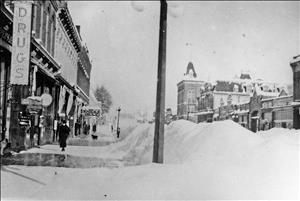On April 8, 1882, fire burns blocks of downtown Dayton, touching off a decade of blazes that will cause hundreds of thousands of dollars in losses. Some of the fires will be started by arsonists, including an 1884 attempt to burn down two of the town's mills.The fires expose the town's vulnerability and its lack of adequate fire protection.
Fire! Fire!
During the early hours of Sunday, April 8, cries of fire carried across Dayton. Flames were burning the back of Thomas & Kirkman’s saloon. People staying in the adjoining Northwest Hotel escaped -- some half-dressed -- by crawling through windows. Others were lucky to stay alive as flames raced from building to building, burning three square blocks. This Sunday morning fire was the third fire in three years to burn in downtown Dayton, and one among a decade of fires -- some deliberately set -- that swept through Dayton’s core beginning in 1880.
The fire swept up Main Street, jumped a cross street, and burned the block to the ground. It engulfed another block before people stopped it by throwing bucket after bucket of water on the buildings. Some buildings, including the post office, bore the signs of a good scorching, but remained standing.
Ingenious Firefighting
The town may have been saved by the ingenious cutting of the mill-race at the flour mill. Water coursed into the street and filled holes the men had dug. Buckets could then be filled and water thrown on the fire. The move saved the post office and the Columbia Hotel. It was written that the fighters of this fire had to roll in the wet streets to cool themselves from the heat.
Though Dayton had grown quickly in the 11 years since Jesse N. Day platted the ground where Patit Creek washes into the Touchet River in what is now Columbia County, some essential services were missing. Among them: adequate fire protection.
Columbia Chronicle newspaper articles, written in the aftermath, called women the most heroic that night: “while able-bodied men stood around just far enough from the fire to enjoy its warmth, fair women and gentle girls were saving thousands of dollars for our businessmen. ... Had the men of Dayton one-half the spunk of the women, we would now have an efficient fire department, with all the needed apparatus” (Shaver, Spokane, 409).
The fire damaged more than 20 businesses. Losses totaled about $90,000, making the fire far worse than the small ones that had burned in the two prior years. A third of the losses were covered by insurance.
In the aftermath of the 1882 fire the Columbia Engine Company No. 1 was founded with 35 members. The City of Dayton, with its incorporation snafu settled, bought a Silsby steam fire engine for $4,750, though historical accounts vary a bit on the cost.
Dayton quickly recovered as brick buildings were built where wooden buildings had stood.
A Decade of Fire
A year after the big 1882 fire, a blaze destroyed Weinhard’s brewery on July 17, 1883.
In January 1884, arsonists attempted to burn Wait & Prather’s flour mill and the planing mill. Parts of each building were soaked with coal oil and set with a powder fuse. A $1,500 reward was offered for the arrest and conviction of the arsonists.
Some business people worried that insurance companies might withdraw from Dayton if there were arsonist bent on burning it down.
On March 27, 1885, the Dayton Woolen Mills burned and suspicions grew.
During the summer of 1886, a bartender named Frank Taylor was arrested in Dayton for setting the mill fires two years earlier, and an accomplice named Dorus B. Hutchings was jailed in McMinnville, Oregon. Under tough questioning, Taylor and Hutchings confessed and fingered local businessman Charles F. McClary. A September trial acquitted McClary. Taylor pleaded guilty and spent two years in prison. The case against Hutchings was dropped.
Wreck and Ruin
It wouldn’t be the end of Dayton’s fire problem. On June 24, 1887, fire burned the Drakes Opera House. A stiff wind blew the flames into wooden buildings and the burn was on. Losses totaled about $112,000.
Yet another fire burned through the downtown on August 11, 1890. This one had started in the back of McClary’s clothing store. On August 16th, the Columbia Chronicle wrote of it: “Ragged walls of brick and smouldering embers alone mark the site of what but a few days since were substantial structures; the sidewalks are strewn with debris; goods saved from the flames are stored anywhere and everywhere, and the wreck and ruin represents to a few discouraged people the toil, the economy and self-denial of years.”
A water work project for Dayton was completed in October 1891, and within a few months the Columbia Fire Engine Company had been disbanded after a decade of service. In its place stood hose companies stationed around the city.

